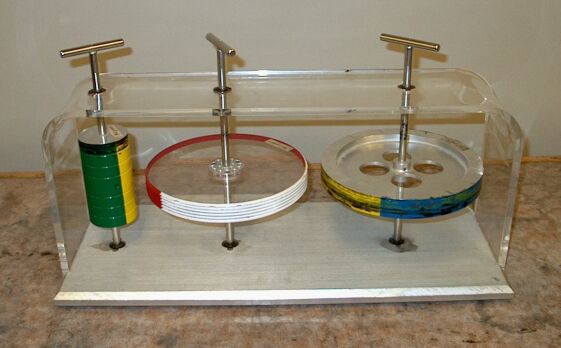

Three wheels of equal mass but different moments of inertia are mounted so that you can spin them by twisting the rods that run through their centers. If you twist the shaft of each one so that they all start at about the same rotational speed, the wheel with least moment of inertia stops rotating first, and the one with the greatest moment of inertia stops last. This demonstration is perhaps better for feeling rather than seeing the difference in moments of inertia, but seeing how fast the wheels are spinning, and then how long each one takes to stop, gives a good sense of how an object’s moment of inertia affects its rotational dynamics. You can invite interested students to come up after class to try spinning the wheels.
All the wheels in this demonstration have a mass of 960 g. The first one (on the left in the photograph) has a diameter of 2.5 inches (6.2 cm), and the other two have a diameter of 8.0 inches (20. cm). The first two wheels have, essentially, a uniform mass distribution, and the wheel on the right has most of its mass near the edge. As discussed in 28.24 – Angular acceleration and 28.30 – Waggle rods with different moments of inertia, the moment of inertia, I, for an object is the sum of the products of all its mass points and the squares of their distances from the axis of rotation, or I = Σmr2. As noted in 28.27 – Roll cylinders down incline, the moment of inertia for a cylinder of uniform mass distribution is (1/2)MR2, and for a hoop it is MR2. The moments of inertia for the three wheels, at least to good approximation, are thus (1/2)(960 g)(3.1 cm)2 = 4.6× 103 g-cm2 (= 4.6 × 10-4 kg-m2), (1/2)(960 g)(10. cm)2 = 4.8 × 104 g-cm2 (= 4.8 × 10-3 kg-m2), and (960 g)(10. cm)2 = 9.6 × 104 g -cm2 (= 9.6 × 10-3 kg-m2), respectively. These moments are roughly in a ratio of 1:10:20. Since the torque you apply is related to the angular acceleration by τ = Iα, for a given applied torque, the greater the moment of inertia, the smaller the angular acceleration. Thus, assuming that you apply the torque over the same amount of time or through the same angle (vide infra), to get the wheels going at the same speed, relative to the torque you apply to the first wheel, you must apply 10 times that torque to the middle wheel, and 20 times as much to the one on the right.
Once you have the wheels spinning, friction in their bearings opposes their motion, accelerating them in the opposite direction and causing them to slow down until they stop. We can express this with the following equation: ω = ω0 + αt. If ω0 is the initial speed of the wheel, and ω, the final speed, equals 0, we then have t = -ω0/α. As we should expect, the greater the angular acceleration, the less time it takes for the wheel to stop (and since ω and α are in opposite directions, the minus sign cancels). Since the torque applied to each wheel by friction is the same (assuming the bearings are all in similar condition), the angular acceleration it can impart to each wheel is α = τ/I, and t = -ω0I/τ. So if the wheels all start at the same speed, it takes the middle one about 10 times as long to stop as it takes the one on the left, and it takes the wheel on the right about 20 times as long. Thus, even if you cannot get the wheels spinning at exactly the same speed, it is not difficult to get their speeds close enough that the wheel on the left stops first, the one in the middle stops next, and the one at right stops last.
When you spin the wheels, as noted above, you can apply a torque either for a given time, or, possibly more likely given the mechanics of trying to turn the T handle at the top of each wheel, over a given angle. For a torque acting over a given angle, we have: ω2 = ω02 + 2αθ. If ω02 = 0, then ω2 = 2αθ, or ω2 = 2τθ/I. So, again, to get the wheels spinning at the same speed, if you apply a torque over a particular angle for each wheel, you must apply 10 times greater torque to the middle wheel, and 20 times greater torque to the right-hand wheel, than the torque you apply to the left-hand wheel. (In all of this, we have been assuming that you can apply the torque in a steady manner over the time or angle for which you apply it.) Also, for the friction to stop the wheels over a particular angle of turning, the angle is θ = ω2I/2τ. We see that the angle over which friction must act to stop each wheel, assuming that they all start at the same speed, is proportional to the wheel’s moment of inertia.